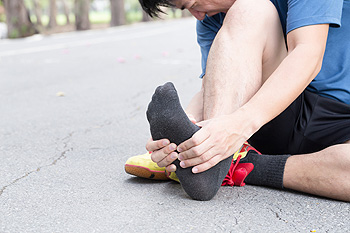
Figuring out If You Have Cuboid Syndrome
 The most common cause for pain in the side of your foot is cuboid syndrome and it occurs when the cuboid, a small bone in the outer foot, is dislocated. This can be a result of an injury to the ankle or just simply repetitive movements that put stress on the outer foot. Unfortunately, this syndrome can sometimes be hard for doctors to diagnose because cuboid misalignments may not show up on x-rays or MRIs. However, these tests do help your doctor eliminate other possible reasons for the outer foot pain. One way doctors diagnose cuboid syndrome is by moving the foot inwards and outwards to see exactly where the pain is stemming from. After receiving a proper diagnosis, this syndrome is easily fixed. Oftentimes, a podiatrist can efficiently relocate the bone, which is followed by only minor aching. If you are feeling pain on the side of your foot and suspect that it may be cuboid syndrome, then it is strongly recommended that you consult with a podiatrist to receive effective treatment.
The most common cause for pain in the side of your foot is cuboid syndrome and it occurs when the cuboid, a small bone in the outer foot, is dislocated. This can be a result of an injury to the ankle or just simply repetitive movements that put stress on the outer foot. Unfortunately, this syndrome can sometimes be hard for doctors to diagnose because cuboid misalignments may not show up on x-rays or MRIs. However, these tests do help your doctor eliminate other possible reasons for the outer foot pain. One way doctors diagnose cuboid syndrome is by moving the foot inwards and outwards to see exactly where the pain is stemming from. After receiving a proper diagnosis, this syndrome is easily fixed. Oftentimes, a podiatrist can efficiently relocate the bone, which is followed by only minor aching. If you are feeling pain on the side of your foot and suspect that it may be cuboid syndrome, then it is strongly recommended that you consult with a podiatrist to receive effective treatment.
Cuboid syndrome, also known as cuboid subluxation, occurs when the joints and ligaments near the cuboid bone in the foot become torn. If you have cuboid syndrome, consult with one of our podiatrists from Coastal Foot & Ankle Wellness Center, LLC. Our doctors will assess your condition and provide you with quality foot and ankle treatment.
Cuboid syndrome is a common cause of lateral foot pain, which is pain on the outside of the foot. The condition may happen suddenly due to an ankle sprain, or it may develop slowly overtime from repetitive tension through the bone and surrounding structures.
Causes
The most common causes of cuboid syndrome include:
- Injury – The most common cause of this ailment is an ankle sprain.
- Repetitive Strain – Tension placed through the peroneus longus muscle from repetitive activities such as jumping and running may cause excessive traction on the bone causing it to sublux.
- Altered Foot Biomechanics – Most people suffering from cuboid subluxation have flat feet.
Symptoms
A common symptom of cuboid syndrome is pain along the outside of the foot which can be felt in the ankle and toes. This pain may create walking difficulties and may cause those with the condition to walk with a limp.
Diagnosis
Diagnosis of cuboid syndrome is often difficult, and it is often misdiagnosed. X-rays, MRIs and CT scans often fail to properly show the cuboid subluxation. Although there isn’t a specific test used to diagnose cuboid syndrome, your podiatrist will usually check if pain is felt while pressing firmly on the cuboid bone of your foot.
Treatment
Just as the range of causes varies widely, so do treatments. Some more common treatments are ice therapy, rest, exercise, taping, and orthotics.
If you have any questions, please feel free to contact one of our offices located in St. Augustine, and Palatka, FL . We offer the newest diagnostic and treatment technologies for all your foot care needs.
Cuboid Syndrome
Cuboid syndrome mostly affects athletes, although it can affect non-athletes too. It is also known as cuboid subluxation or cuboid fault syndrome. This condition occurs when joints and ligaments near the cuboid bone of the foot are damaged, or when the cuboid bone itself is dislodged from its natural position. It is usually marked by pain on the outer side of the foot, which may be persistent or may come and go. Cuboid syndrome can be difficult to diagnose unless it becomes severe and more noticeable. Your doctor will likely ask questions about when the pain began and how long it has been present, and will put pressure on the cuboid bone to determine if that area is the origin of the pain.
Causes of Cuboid Syndrome
- Any repetitive stresses placed on the foot due to athletic activities are a common cause of cuboid syndrome.
- Although it develops over time, it is possible that this syndrome can occur all of sudden due to a single event or injury.
- Over-pronation can exacerbate the condition if not corrected.
Disagreements Amongst Podiatrists Regarding Cuboid Syndrome
- Some refer to it as the dislocation of the calcaneal-cuboid joint only.
- Other podiatrists see it as an injury of the ligaments located nearby, which also involves the cuboid bone.
It is very important that when you experience any kind of pain on the side of your foot, you should seek medical care right away. If a subluxed cuboid is caught early, your feet may respond well to the treatment, and you can get back into sports or other activities again as soon as the pain subsides.








